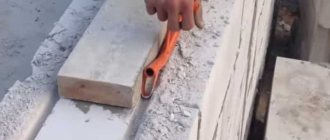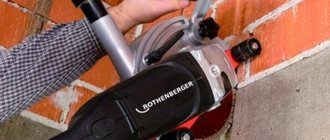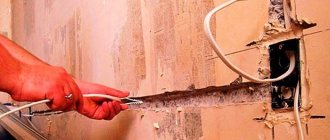Nozzle – wall chaser
The selection begins with an interesting attachment that turns an angle grinder into a full-fledged wall chaser. The device allows you to install two saws at once for direct and precise cutting of grooves with a width of 12 mm. The attachment supports cutting wheels with a diameter of 125 and 100 mm. On the back of the device there is a connector for connecting a vacuum cleaner. The cutting depth can be adjusted using three reliable clamps.
Product photo taken by the buyer:
Customer Feedback:
FIND OUT PRICE
Features of working with a homemade wall chaser
The internal structure of a factory wall chaser is somewhat different from an angle grinder - it is designed for one single task, is simplified as much as possible and requires higher quality components. The force on the angle grinder shaft is transmitted through an angular gearbox and everything is designed for cleaning surfaces and cutting iron.
The forces generated when cutting the groove quickly damage the gearbox and bearings. This is facilitated by the double load on the mechanism components and the fact that the second disk is not located at the design location, which means that the force is transmitted at a different angle.
In any case, the cost of a wall chaser is an order of magnitude higher than that of an angle grinder and it is often easier to buy a new angle grinder than one furrower. But this should not prevent you from following simple recommendations that will prolong the life of a homemade wall chaser made from an angle grinder:
- It is necessary to ensure that the instrument does not overheat and, if possible, give it a rest as often as possible.
- It also wouldn’t hurt to evaluate how much faster working with two disks is than with one. A protective casing with adjustable cutting depth provides protection from dust and relatively even grooves, even if you make two parallel cuts. If unnecessary movement along the wall with a wall chaser with one disk will extend its service life, then it may be worth limiting yourself to this option.
As a result, a high-quality do-it-yourself wall chaser works no worse than the factory original, but there is a risk of quickly rendering the angle grinder, which is used as its basis, unusable. If you have to cut grooves often, then it is better to purchase your own furrower, designed specifically for wall grooves, and a grinder converted into a wall chaser is more suitable for periodic work.
Belt Sander Adapter
Using this adapter, you can turn your angle grinder into a compact machine for grinding wood, metal and other materials. The width of the abrasive belt is only 10 mm, which will allow you to comfortably work with the device in hard-to-reach places. On the top side there is a chip discharge for a construction vacuum cleaner. Overall dimensions of the adapter: 255*63 mm. Suitable for M10/M14.
Product photo taken by the buyer:
Customer Feedback:
FIND OUT PRICE
A little about gating
A groove (the term “furrow” is less commonly mentioned) consists of two parallel grooves, the width and height of the walls of which determine the possibility of installing communications in it. To make grooves, the following groove dimensions are required:
- Width from 3 to 50 mm (the first option provides for laying only power and low-current cables in the groove, the second - for installation of heating system pipes);
- The depth of the groove is no less than its width, but it is better with a small margin of 5...10 mm;
- The bottom of the groove is smooth, without protrusions.
Sometimes you have to cut inclined grooves. For oblique grooves, all specified dimensions are usually increased by 10...12%. The groove should be as even as possible, since any slope of the groove will automatically increase the length of the cable or pipe. The distance from the groove axis to adjacent ceiling structures, openings, etc. must be at least 150 mm, and to the gas pipeline elements - at least 400 mm.
The material of the walls also matters. Since the groove is obtained by removing material from under the tool disk, all dust and stone fragments fall into the worker. Even when performing such work in walls made of foam or aerated concrete, the need for dust collection is very important, since fine dust will remain in the air for a long time.
In a professional wall chaser, all these problems are solved by connecting a vacuum cleaner with a cyclone filter to the tool. Ordinary mesh ones will become clogged with gating products within a few seconds of continuous operation of the wall chaser.
The second significant difference between gating with a specialized tool is the presence of a movable frame with wheels, which, when controlled, can significantly reduce the load on the worker’s hands. A single-disc wall chaser attachment for an angle grinder does not fundamentally solve the problem, since the depth of the groove is not limited in any way, and manual removal of the jumper is very labor-intensive and does not ensure good quality of the bottom of the resulting groove. In addition, during the second pass it will not be easy to achieve parallelism of the walls of the groove.
Adapter - renovator
A useful device for most angle grinder owners. With its help, an ordinary grinder expands its functionality into a renovator. This universal tool is useful for cleaning various surfaces, cutting grooves for grooves, cutting tiles, etc. The adapter comes with a set of blades of different lengths and a sanding disc.
Product photo taken by the buyer:
Customer Feedback:
FIND OUT PRICE
If you use a grinder instead of a wall chaser
an angle grinder with a homemade dust extractor, suitable for small jobs.
It is clear from the design that, in extreme cases, the machine for making grooves can be replaced with an ordinary angle grinder - put a concrete disc on it and make the necessary cuts in two passes. This is actually done if one small groove is needed, but practice and multiple reviews show that the dust after such a groove will settle for a long time, which can stall the whole work.
If it is necessary to make several grooves, the loss of time will be significant, and if such work is performed with some frequency, then the method becomes ineffective. Other disadvantages of this method are the inability to maintain the same dimensions of the groove edges and their depths. This cannot be called a significant drawback, but sometimes it can lead to a piece of the wall falling off when the core of the groove is hollowed out.
If the length of the mounting shaft allows, then you can put two concrete discs on the grinder at once and then the groove will be cut in one go. Even if we do not touch upon the issue of safety precautions, there will be no less dust and it will settle at the same speed. As a result, the time gain is insignificant, and the risk of injury increases by an order of magnitude.
Method number 3. Hammer
Another common and fairly simple way to make a wall chaser yourself is to use a hammer drill. But instead of the usual drill, you should insert a cutter of the required size into it.
Such a wall chaser is quite simple and does not require much time and effort to manufacture, but at the same time it produces a very low quality of work. The groove is not only curved in height and length, but also of different depths and widths. As a result, you will have to spend much more time on gating and a much larger amount of finishing materials.
What recommendations and tips to consider when gating
You can begin the procedure for preparing grooves indoors immediately after making your homemade product. When punching a groove, one important nuance must be taken into account - the work should be carried out in a room where the location of the electrical wiring is previously known. If a live wire is encountered along the path of the tool, the result of such an encounter can be fatal for the master.
It is necessary to carry out gating work with both a conventional wall chaser and an angle grinder, taking into account the following tips and recommendations:
- Procedures can be carried out in vertical or horizontal directions
- It is possible to ditch at an angle in extremely rare cases when it is necessary to bypass a decorative element or communications
- Horizontal grooves must be carried out exclusively at a distance of up to 15 cm from the floor slab
- Vertical grooves must be located at a minimum distance from doors and windows of 10 cm
- When carrying out work, it is important to take into account the depth of the groove. It is necessary to select the depth depending on the type of communications that are planned to be laid in the groove, as well as the thickness of the wall itself. If this wall is load-bearing and is external, then the depth of the groove should not be more than 3 cm
- The width of the groove is also selected depending on the technological task, but it is not recommended to exceed the permissible limit of 2.5-3 cm
After laying communications, the groove should be sealed with cement mortar. The location of the groove should be leveled with the plaster of the wall. It is recommended to carry out gating work at the construction and repair stage before plastering the walls.
It is not at all difficult to make a wall chaser for concrete from an angle grinder, and if you set yourself such a goal, then everyone can achieve it. When drawing a conclusion about the work done, it should be noted that when chipping, you need to take breaks to allow the power tool to cool down. If the cover does not have a connector for connecting a vacuum cleaner, then work must be carried out in a respirator. Glasses must be worn in any case, as various small particles can get into the eye.
Depending on the type of material that is being cut, it is necessary to select the appropriate speed of movement of the tool. If you come across reinforcement in a concrete wall on the way, it is recommended to saw it with an abrasive wheel. It is necessary to use a wall chaser on wood with extreme caution, not forgetting about the backlash.
Sources
- https://kustari-f.ru/dom-s-nulya/pylesos-dlya-shtroboreza-svoimi-rukami.html
- https://obrabotkametalla.info/pilit/vybiraem-nasadku-shtroborez-na-bolgarku-ili-pilu
- https://prorab.guru/insrtrument/kak-sdelat-shtroborez-svoimi-rukami.html
- https://sdelairukami.ru/3-prostyh-idei-kak-sdelat-shtroborez-svoimi-rukami/
- https://bouw.ru/article/shtroborez-nasadka-na-bolgarku
- https://www.asutpp.ru/shtroborez-svoimi-rukami.html
- https://moiinstrumentu.ru/nasadka-na-bolgarku-shtroborez-samostojatelnoe-izgotovlenie.html
[collapse]
What is a wall chaser for aerated concrete?
When renovating apartments, homeowners take a new approach to the placement of utility networks and various communications:
- water supply pipes;
- heating lines;
- power cables;
- sewer risers.
Wall chaser for aerated concrete It is understandable that apartment owners want to place communications inside the walls and thereby improve the appearance of the premises. The technology for hidden placement of highways involves the creation of special grooves. In the vocabulary of professional builders, such channels are called grooves. For their production, a gas silicate wall chaser is used. The tool began to be used relatively recently. Before its appearance, equipment was used for chiselling grooves that created vibration during operation and negatively affected the strength of building structures:
- a bolt or chisel that was struck with a hammer. The process of creating the grooves was slow and required considerable effort;
- pneumatic hammer. The tool created increased noise and significant vibration. A lot of dust was also present during the formation of the channel;
- industrial hammer drill. During the formation of cavities, vibration negatively affected the strength of concrete and caused the formation of cracks.
The use of these types of equipment required significant physical effort and was characterized by reduced productivity and increased labor intensity. Increased concentration of dust, significant noise and vibration caused a lot of inconvenience. The outdated equipment was replaced by a wall chaser for aerated concrete - a hand-held tool that has many advantages:
- reduces the duration of laying channels in walls;
- reduces the labor intensity of construction operations for gating;
- allows you to provide the necessary channel geometry in various building materials;
- provides the ability to adjust the width and depth of the cavity being formed;
- removes dust from the treated area, reducing dust concentration;
- forms a channel of the correct shape with constant dimensions along the length.
Industrial wall cutter for aerated concrete For one-time work, there is no need to purchase an industrial wall cutter for aerated concrete, which is quite expensive. There is a good solution - you can assemble a wall chaser from an angle grinder with your own hands. Drawings are not needed for this modernization, because the design is simple. Using available materials, you can expand the technical capabilities of home tools equipped with an aspiration system.
The use of a self-made tool ensures:
- reducing the cost of plastering the groove due to the neat shape of the channel. The resulting groove does not require an increased amount of plaster;
- the ability to cut grooves in building materials with increased hardness. In this case, two cuts are performed at once in one pass.
After processing, all that remains is to remove the cut building material located between the cuts, and you can begin laying communications.
What to make a protective dust cover for an angle grinder from
The manufacture of a protective casing involves the use of such types of materials as a plastic canister, aluminum pans, chipboard, plywood, laminate, board, stainless sheets, etc. You can choose any material that is available on the farm. This eliminates the need to buy an attachment, since making it with your own hands is very easy and simple.
The main condition is to ensure sufficient strength of the finished attachment for the grinder. The casing must withstand the impact of small particles of concrete flying out during work. To make the casing, there is no need to resort to the use of auxiliary tools, such as welding, since a nozzle can be quickly made from a plastic canister. An example of such a nozzle is shown in the photo below.
The manufacture of such a device requires a minimum of time. A homemade wall chaser from an angle grinder can be made quickly and easily, using an arsenal of improvised tools. If you use materials made of aluminum or wood, then when working on the manufacture of nozzles you will need self-tapping screws, and when using steel you cannot do without a welding machine. Let's consider the principle of making a wall chaser attachment for an angle grinder with your own hands:
- For production you will need leftovers from chipboard or fiberboard. In addition, even plywood will do, so we use any sheet material that is available
- Two side bases are cut out of chipboard according to the appropriate shape. The shapes of these bases depend on the size of the available tool
- To avoid having to select a shape, it is recommended to first make a drawing on paper and then transfer it to cardboard. Make a template from cardboard, eliminating all the shortcomings
- Based on the template, make a cover using chipboard
- Drill a hole of the appropriate diameter on one side of the chipboard base. Use this hole to secure the finished attachment to the power tool.
- To connect chipboard when making the nozzle, you can use self-tapping screws or special furniture fasteners of appropriate length
The photo below shows the resulting case for the grinder. Such a cover is easy to make, but its drawback is the absence of a hole for connecting a hose. A sleeve of the appropriate diameter and length, which must be mounted in the upper part of the structure, will help eliminate this drawback. A hose from a vacuum cleaner should be connected to the protrusion of the sleeve. This is interesting! When using a vacuum cleaner to suck up debris and concrete chips, it is recommended to use industrial or construction vacuum cleaners, but not household ones. They are not designed for such things, so in the end they can quickly fail.
The process of making a nozzle is not difficult, and the quality of the final device depends more on the ingenuity and imagination of the master. You can make not just a simple case for an angle grinder with your own hands, but also an adjustable one. The principle of manufacturing an adjustable protective casing is that you need to make an additional moving part. Due to this moving part, the required size of the protrusion of the cutting discs on the grinder will be selected.
In a similar way, you can make a nozzle with an adjustable part from chipboard and other materials.









